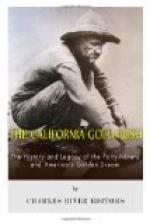The Law and Order people recognized the strength of this organization and realized that they must go at the matter in a more thorough manner. They turned their attention to the politics of the structure, and here they had every reason to hope for success. No matter how well organized the Vigilantes might be or how thoroughly they might carry the sympathies of the general public, there was no doubt that they were acting in defiance of constituted law, and therefore were nothing less than rebels. It was not only within the power, but it was also a duty, of the Governor to declare the city in a condition of insurrection. When he had done this, the state troops must put down the insurrection; and, if they failed, then the Federal Government itself should be called on. Looked at in this way, the small handful of disturbers, no matter how well armed and disciplined, amounted to very little.
Naturally the Governor had first to be won over. Accordingly all the important men of San Francisco took the steamer Senator for Sacramento where they met Judge Terry, of the Supreme Court of California, Volney Howard, and others of the same ilk. No governor of Johnson’s nature could long withstand such pressure. He promised to issue the required proclamation of insurrection as soon as it could be “legally proved” that the Vigilance Committee had acted outside the law. The small fact that it had already hanged two and deported a great many others, to say nothing of taking physical possession of the city, meant little to these legal minds.
In order that all things should be technically correct, then, Judge Terry issued a writ of habeas corpus for William Mulligan and gave it into the hands of Deputy Sheriff Harrison for service on the Committee. It was expected that the Committee would deny the writ, which would constitute legal defiance of the State. The Governor would then be justified in issuing the proclamation. If the state troops proved unwilling or inadequate, as might very well be, the plan was then to call on the United States. The local representatives of the central government were at that time General Wool commanding the military department of California, and Captain David Farragut in command of the navy-yard. Within their command was a force sufficient to subdue three times the strength of the Vigilance Committee. William Tecumseh Sherman, then in private life, had been appointed major-general of a division of the state militia. As all this was strictly legal, the plan could not possibly fail.
Harrison took the writ of habeas corpus and proceeded to San Francisco. He presented himself at headquarters and offered his writ. Instead of denying it, the Committee welcomed him cordially and invited him to make a thorough search of the premises. Of course Harrison found nothing—the Committee had seen to that—and departed. The scheme had failed. The Committee had in no way denied his authority or his writ. But Harrison saw clearly what had been expected of him. To Judge Terry he unblushingly returned the writ endorsed “prevented from service by armed men.” For the sake of his cause, Harrison had lied. However, the whole affair was now regarded as legal.




